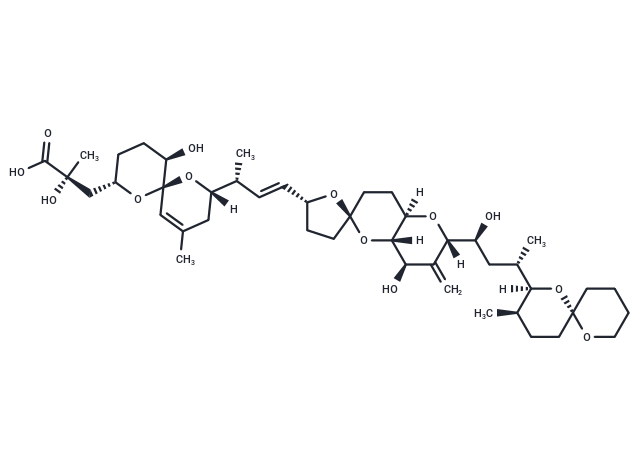 Your shopping cart is currently empty
Your shopping cart is currently empty

Okadaic acid is a potent polyether marine toxin that primarily accumulates in the digestive glands of marine mollusks. It is a highly effective and selective inhibitor of protein phosphatases (PPs). By inhibiting these phosphatases, okadaic acid increases the phosphorylation levels of various proteins, acts as a tumor promoter, and induces tau protein phosphorylation. It can be used to establish models of Alzheimer’s disease and skin cancer.

| Pack Size | Price | USA Warehouse | Global Warehouse | Quantity |
|---|---|---|---|---|
| 25 μg (124.2 μM * 250 μL in Ethanol)" | $200 | In Stock | - | |
| 50 μg (124.2 μM * 500 μL in Ethanol) | $300 | 35 days | 35 days | |
| 100 μg (124.2 μM * 1 mL in Ethanol) | $460 | - | In Stock |
| Description | Okadaic acid is a potent polyether marine toxin that primarily accumulates in the digestive glands of marine mollusks. It is a highly effective and selective inhibitor of protein phosphatases (PPs). By inhibiting these phosphatases, okadaic acid increases the phosphorylation levels of various proteins, acts as a tumor promoter, and induces tau protein phosphorylation. It can be used to establish models of Alzheimer’s disease and skin cancer. |
| Targets&IC50 | PP7:>1000 nM, PP5:3.5 nM, PP2A:0.1-0.3 nM, PP3:4 nM, PP3:3.7-4 nM, PP1:10-15 nM, PP4:0.1 nM, PP2:0.5 nM, PP1:15-50 nM, PP2B:~4000 nM |
| In vitro | Okadaic acid, at concentrations ranging from 0 to 100 nM and after treatment periods of 24 or 48 hours, is capable of inhibiting the proliferation of AGS, MNK-45, and Caco 2 cells[3]. |
| In vivo | Okadaic Acid (100 μg; icv; single dose) can be used in male Wistar rats (250-300 g) to establish an Alzheimer's disease model[6]. |
| Disease Modeling Protocol | Establishment of Alzheimer's disease model
*Precautions: The above data are from literature and for reference only. It is recommended to determine the optimal experimental conditions based on preliminary experiments. |
| Molecular Weight | 805 |
| Formula | C44H68O13 |
| Cas No. | 78111-17-8 |
| Smiles | O[C@H]1[C@@]2(O[C@]([C@@H](/C=C/[C@@H]3O[C@]4(CC3)O[C@@]5([C@@](CC4)(O[C@]([C@H](C[C@H](C)[C@]6(O[C@]7(CC[C@H]6C)CCCCO7)[H])O)(C(=C)[C@H]5O)[H])[H])[H])C)(CC(C)=C2)[H])O[C@H](C[C@@](C(O)=O)(C)O)CC1 |
| Relative Density. | 1.0795 g/cm3 (Estimated) |
| Color | Transparent |
| Appearance | Liquid |
| Storage | store at low temperature | Powder: -20°C for 3 years | In solvent: -80°C for 1 year | Shipping with blue ice/Shipping at ambient temperature. |
| Size | Quantity | Unit Price | Amount | Operation |
|---|

Copyright © 2015-2025 TargetMol Chemicals Inc. All Rights Reserved.